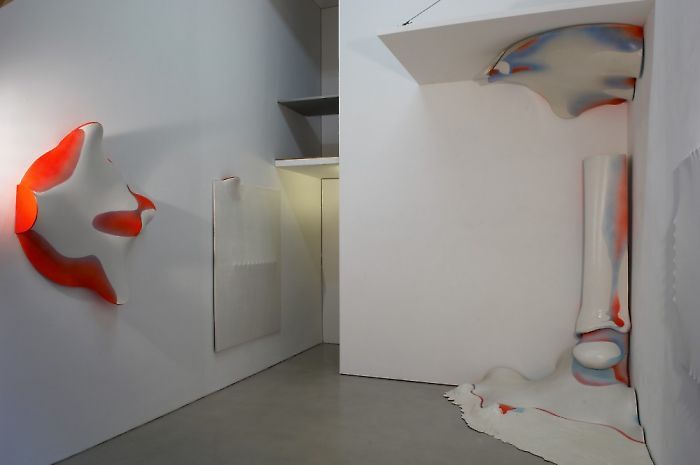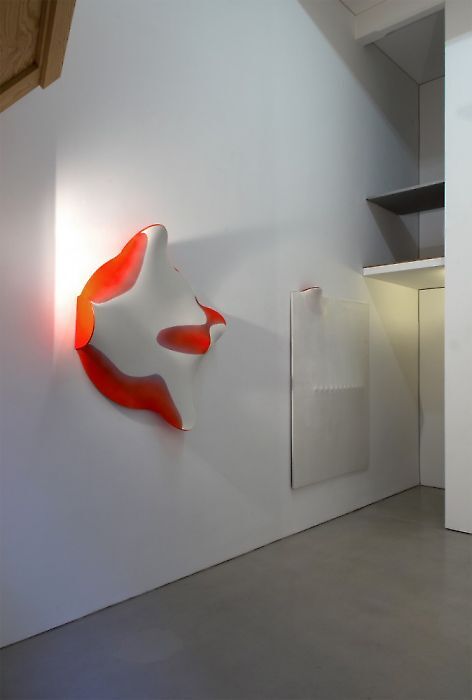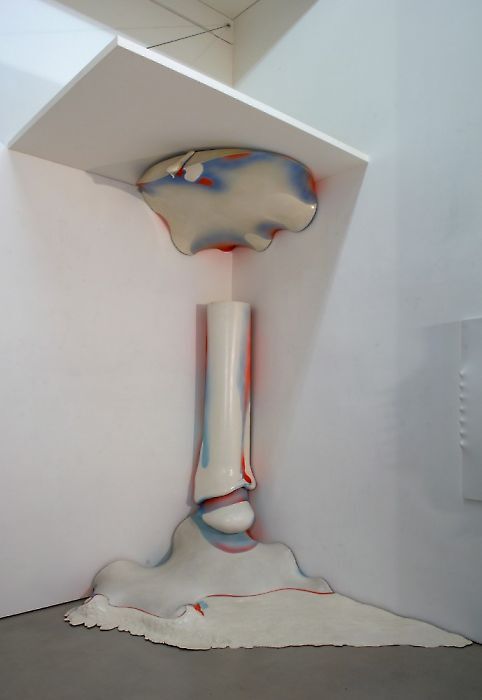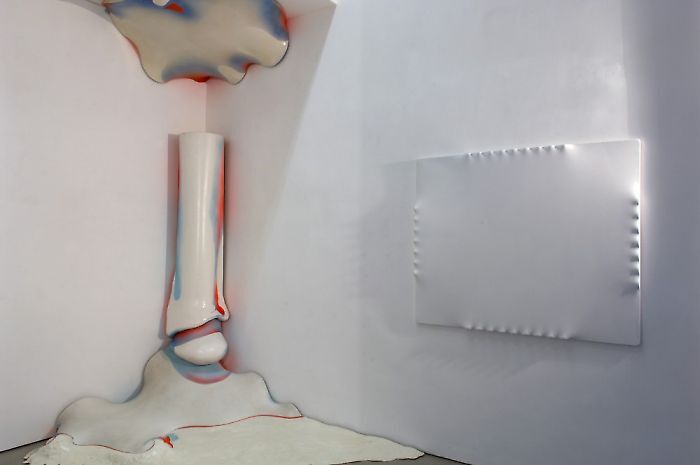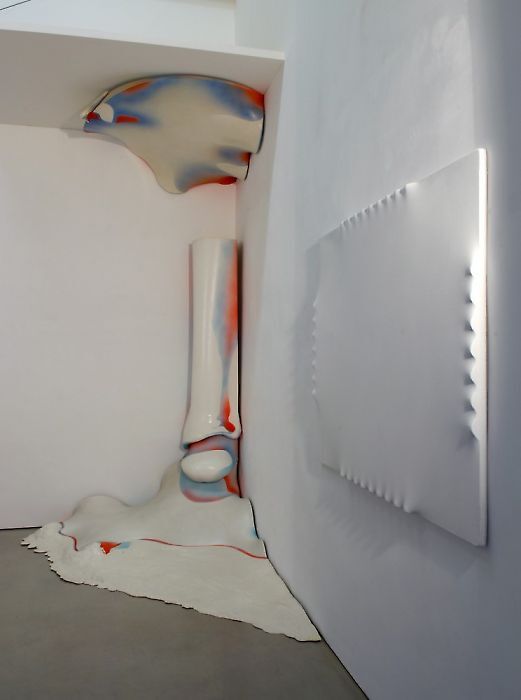—
Erwin Thorn
In engaging with the discourses of the conceptual avant-garde in the 1960s, Erwin Thorn developed an independent artistic position all his own. “Occasional affinities can be made out to the visual strategies of a Hans Bischoffshausen, as well as forms parallel to the work of the artists in the Düsseldorf ZERO group around Heinz Mack, Otto Piene, and Günther Uecker. At the same time, he is interested in the work and attitude of Karl Prantl,” as Roland Schöny summarizes.(1)
In large spatial installations, sculptural images or image-like sculptures, collages and fine paper works, he explores emancipative perspectives with the concept of language and reversal when it comes to the question of traditional relationships and the visual communication of events. Rhythm and waves—also reminiscent of sound waves, thus making clear the audio aspect of language—are an important aspect of Thorn’s conceptual work. “His visual language can be described as a visual, linguistic system, in which the coordinates consist of elevations and depressions,” and consciously sets himself apart not only “from the individual gestural work of abstract expressionism, art autre, and the Informel” (Schöny), but also distances himself from the esoteric interests of European art movements. His turn away from the pathos-laden formulas of the 1950s and 1960s is exhibited in a “reductionistically formal order,” as Thorn himself describes.(2) Here, “nothing is not nothing, but a breathing surface” that with an architectural character explores constructs in spatial terms and seems systematized by concave and convex distortions. Beyond any mannerisms, he intervenes in the flat surfaces, manipulating them, executing his formal principles in different work groups. A change in the beholder’s perspective makes clear the complex play with structures with shadow and light, omissions and distortions, visible forms, and those first revealed by the movement of the beholder, which Thorn conceives as symbolic.
With irony and humor, Thorn breaks the semiological plane over and over. The term Ohrwaschel, an invented word (the English equivalent might be “ear waxel”) some of the objects humorously makes clear the linkage of elevations and depressions as forms, visual associations to the tone-setting rhythms and language. He conceives “the visual medium as a language, and language does indeed transport content” (Thorn).
In so doing, “earnestness and sensuality are by no means mutually exclusive, but the condition for one another” (Schöny). All of Thorn’s formal studies are committed to this primacy, as is clearly shown in the biomorphic spatial installation Von der Wiege ins Boot [From the Cradle to the Boat]. Inserted into the corner of a room, a vertical reminiscent of a joint with bones seems to coagulate at the margins, reminiscent of “very delicate drops,” as Alfred Schmeller in 1960 wrote on a Throrn sculpture, by and in so doing, the “plausible result of a critical reflection about the Greek column as a symbol of power” (Schöny).
(1) Roland Schöny, “Zum Werk des Künstlers Erwin Thorn: Konzeptuelle Avantgarde mit ironischen Tupfern,” Parnass 03 (2008), pp. 98–102.
(2) “Farben Lust und Form Gedanken,” Abstrakte Wege in Österreich 1900 – 2000, eds. Gabriela Nagler and Erika Patka, p. 119.
Biography
1930 - Vienna - 2012
Selected Solo Exhibitions
2024
approaching space - androgynous, approaching space - meta-a-morphosis, Georg Kargl Fine Arts, Vienna
2010
Apropos Blei, in Anbetracht der Wörter, die Beredsamkeit der Folie, Georg Kargl Permanent, Vienna
2008
Erwin Thon, Georg Kargl Box, Vienna
1979
Arbeiten 1959-1979 und work in progress - Dokumentation, Modern Art Galerie, Vienna
1972
Spiele Spielen, Galerie nächst St. Stephan, Vienna
1971
WEISS, Museum des 20. Jahrhunderts, Vienna
1970
Galerie im Taxispalais, Innsbruck
1969
Galerie nächst St. Stephan, Vienna
1967
Österreichisches Kulturforum, Rome
1964
Galerie Wulfengasse 14, Klagenfurt
Selected Group Exhibitions
2025
TERRA INCOGNITA - Kunst-Expedition in ein unbekanntes Nachbarland. Tschechoslowakische Kunst zwischen 1948 und 1989 im Dialog mit der Sammlung Liaunig, Musem Liaunig, Neuhaus
2024
Selection – Highlights from the collection, Neue Galerie Graz, Universalmuseum Joanneum, Graz
Blind Date - Die Sammlung Maximilian und Agathe Weishaupt im Dialog mit der Sammlung Liaunig, Museum Liaunig, Neuhaus
Pop Art, The Bright Side of Life, Albertina Klosterneuburg, Klosterneuburg
From Fibre to Form, Kunthaus Dahlem, Berlin
2023
Picture This! The Belvedere Collection from Cranach to EXPORT, Belvedere, Vienna
2022
Lost in Space, Raum, Ding und Figur – Entwicklungen innerhalb der Skulptur seit 1945, Museum Liaunig, Neuhaus/Suha
2021
Avantgarde und Gegenwart. Die Sammlung Belvedere von Lassnig bis Knebl, Belvedere 21, Vienna
2020
The Beginning. Kunst in Österreich 1945 - 1980, Albertina Modern, Vienna
2019
Alfred Schmeller. Das Museum als Unruheherd, mumok, Vienna
2018
CONCENTRATION - a tribute, Gesellschaft für projektive Ästhetik, Georg Kargl, Vienna
Umrahmung schräg gekippt. Sammlung Liaunig in Bewegung, Museum Liaunig, Neuhaus
Reduction, Gesellschaft für Projektive Ästhetik, Georg Kargl, Vienna
2017
Ästhetik der Veränderung. 150 Jahre Universität für angewandte Kunst Wien, MAK, Vienna
European Abstraction from the 1960’s & 1970’s, Stellan Holm Gallery, New York
2016
Carol Bove meets ZERO, Galerie Koch, Hannover
2015
Zero. Positionen, Galerie Koch, Hannover
2014
Impulse, Reason, Sense, Conflict, CIFO – Cisneros Fontanals Art Foundation, Miami
Texte in der Kunst, Georg Kargl Fine Arts, Vienna
2013
Zero Avantgards 1965 – 2013, Galleria Christian Stein, Milan
2012
1964, Georg Kargl Fine Arts, Vienna
2010
High Ideals & Crazy Dreams-Groupshow, curated by Gerwald Rockenschaub, Galerie Vera Munro, Hamburg
Personal Structures. Time – Space – Existence, Künstlerhaus Palais Thun und Taxis, Bregenz
Personal Structures. Time – Space – Existence, Georg Kargl Fine Arts, Vienna
Fine Line, Georg Kargl Fine Arts, Vienna
2009
Feedbackstage, Georg Kargl Fine Arts, Vienna
Feedbackstage, Galerie Thomas Schulte, Berlin
2001
Farbenlust und Formgedanken. Abstrakte Wege in Österreich 1900-2000, Heiligenkreuzerhof, Vienna
2000
Farbenlust und Formgedanke. Abstrakte Wege in Österreich 1900-2000, Frauenbad, Baden bei Wien
1996
Die 60er Jahre oder als alles möglich wurde. Kunst und Kultur in Österreich 1960-1970, Schloß Herberstein, St. Johann bei Herberstein
1984
1984 - Orwell und die Gegenwart, Museum des 20. Jahrhunderts, Vienna
1971
Aquarelle - Druckgraphik - Handzeichungngen - Plastik, Galerie Krinzinger, Bregenz
1970
Nebenprodukte, Galerie nächst St. Stephan, Vienna
Österreichische Kunst 1979, Schloß Eggenberg, Graz
1969
Hommage an das Schweigen, Tiroler Kunstpavillon, Innsbruck
Surrealismus ohne Surrealisten - Künstler ohne Kunst, Galerie nächst St. Stephan, Vienna
Surrealismus ohne Surrealisten - Künstler ohne Kunst, Galerie im Taxispalais, Innsbruck
1968
Werke der III. Internationale Malerwoche, Neue Galerie Joanneum, Graz
Neue Dimensionen der Plastik in Österreich, Galerie Taxispalais, Innsbruck
Plastiken und Objekte, Museum des 20. Jahrhunderts, Vienna
Symposium, Retzhof
1966
Zero avantgarde 1966, Galleria associazione Zen, Brescia
Zero avantgarde 1966, Il Segno, Rome
Konfrontation 66, Galerie Heide Hildebrand, Klagenfurt
1965
Bischoffshausen, Hartlauer, Prantl, Thorn, Forum Stadtpark, Graz
Zero avantgarde 1965, Atelier di Fontana, Milan
Zero avantgarde 1965, Galleria del Cavallino, Venice
Zero avantgarde 1965, Galleria il Punto, Turin
Aspekten van een nieuwe Konseptiez, Galerie 20, Arnhem
Biennale nova tendencija III, Gallery of Contemporary Art, Museum of Arts and Crafts, Zagreb
1964
Biennale Art Sacre, Paris
1962
Symposion Europäischer Bildhauer – Kleinplastiken, Galerie im Griechenbeisl, Vienna
1960
International Biennal of Prints, Cincinnati Art Museum, Cincinnati (OH)
Sommerausstellung, Galerie im Griechenbeisl, Vienna
Galerie Junge Generation, Vienna
Inquiry
Please leave your message below.
